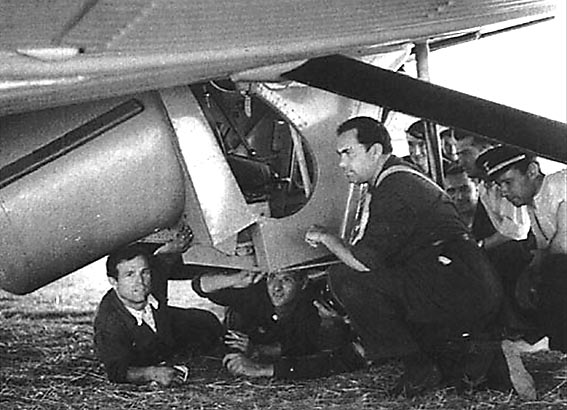 |
||
 |
 |
 |
 |
 |
| Jesus Christ, we’re out of gas! © Lennart Andersson |
|
That is what flight mechanic Fritz Reiche, would have exclaimed if the had spoken English. What he probably said was: - Verdammt, Krist, wir haben kein Benzin mehr! 
He was saying that to Theodor Krist (sometimes spelt Christ), the pilot of Junkers Ju 52/3m D-AMYM, as they were approaching the Spanish city of Azuaga, about 110 km northeast of Seville. With them on board were radio operator Wilhelm Küppers and all three were employees of German Lufthansa airline company. There was a fourth man on board, Heinrich Degunhart, who was a representative of Junkers Flugzeug- und Motorenwerke at Dessau. They ran out of fuel, Krist found a suitable field and made an emergency landing without any damage to the aircraft. This happened on 9 August 1936 and a civil was had just erupted in Spain. The fascists under Franco had revolted against the elected Republican government and Franco and his Nationalists were getting military aid from Germany and Italy. A number of three-engine Ju 52/3m aircraft that could be used both as bombers and for transport were part of the German arms deliveries and D-AMYM was one of them. The problem was just that the place where it had landed was still in Republican hands. 
It was a Sunday morning and this Ju 52/3m had first unexpectedly landed at Barajas civil airport, Madrid. After the crew had exchanged a few words with a man on the ground, it quickly took off again. The man was Joseph Bastian, a Lufthansa radio operator, and he told them that they were in Madrid, which was in Republican hands, and not Seville, which was their destination. Airport manager Ernesto Navarro realised that something was wrong and immediately had Bastian arrested. The place where the aircraft finally landed, the Tarilla farm, 5 kilometres from Azuaga, was not far from the front and it remained in government hands until 24 September. Ju 52/3m D-AMYM was a new aircraft and had been flown for the first time by Junkers test pilot Karl Maringer on 28 May. As can be seen from the photos, it was fitted out as a bomber with dorsal and ventral machine gun stands and it had extra tanks fitted inside the cabin for the long flight to Spain. The bomb magazines and MG 15 machine guns were embarked on the steamer Usamo, which sailed from Hamburg on 1 August and arrived in Cádiz five days later. On 10 August the Spanish authorities confiscated the aircraft and Capitan Antonio Rexach flew it to Madrid. Rexach was aided by the German mechanic during the flight and was greatly impressed by the perfectly finished aircraft. A map with airfields in rebel territory and a German newspaper from 8 August was found in the cockpit. 
In September, a committee investigating violations of a non-intervention agreement that was to prevent the delivery of arms to Spain looked into the matter and the interrogations of the Germans were summarised in an official document. The crew said that they had orders to take the aircraft to Seville “so that the German consulate could use it in the event of evacuating refugees”, which was clearly a cover story. Their destination had been Barcelona, but in the middle of the flight they were ordered by radio to fly to Seville instead. According to the mechanic, they had flown from Dessau via Stuttgart and they did not know that the boxes carried in their aircraft contained rifles and ammunition. The order to fly the aircraft to Spain came from Junkers director Fritz Achterberg. Escorted by police, the Germans were sent on the first train to Madrid, where they were interrogated in the presence of the German charge d’affaires. The whole matter turned into a diplomatic conflict; as the German embassy in Madrid gave the Spanish Republic an ultimatum threatening to break off relations, if the Junkers crew were not released immediately. On 15 August, yielding to strong German pressure, the crew was handed over to the German embassy in Madrid. 
The aircraft was repainted in Republican colours and was kept in a hangar at Barajas. It was destroyed in a Nationalist bomb raid on 26 October. The Germans, confident that the Nationalists would soon capture the capital, had left a clandestine ambassador, Manuel Ahles, in the city and on the following day he went to Barajas, to inspect the result of the bombardment and noticed that the Ju 52/3m had been destroyed. Note: Many Ju 52/3m bombers were delivered to Spain and the type became infamous for the bombing of the city of Guernica in April 1937. The registration D-AMYM was later re-used for another Ju 52/3m (c/n 6015) in May 1938 |